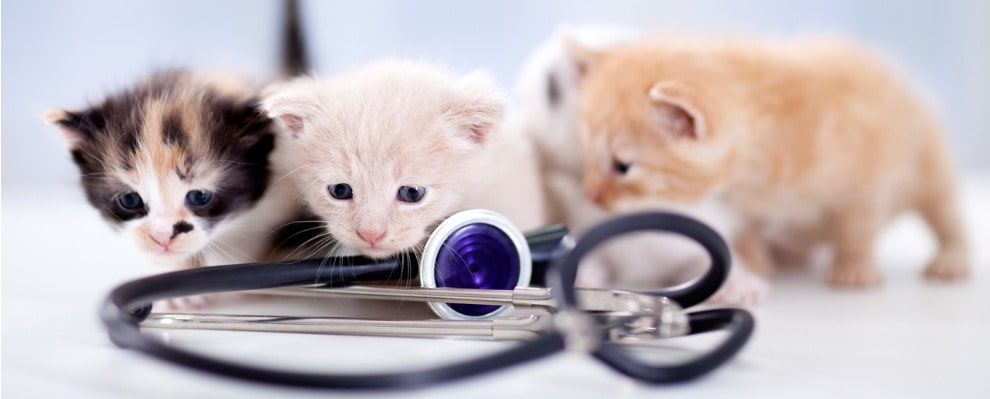Search Programs
When you click on a sponsoring school or program, or fill out a form to request information from a sponsoring school, we may earn a commission. View our advertising disclosure for more details.

Graduating from veterinary technician school is an accomplishment to celebrate, but for many, it’s overshadowed by financial worry. According to Forbes, about half of all college graduates with two- and four-year degrees carry $30,000 in debt after earning their degrees. Veterinary technician school can be expensive, and many graduates need help knowing how to repay their loans and start their careers on solid financial footing.
Fortunately, there are loan forgiveness and repayment plans available for vet techs. These programs provide reduced or entirely subsidized repayment of student loans in exchange for service as a veterinary technician. Many loan forgiveness plans involve working in public service, sometimes in rural areas.
Fortunately, rural veterinary care is a top advocacy priority for the American Veterinary Medical Association (AVMA). By meeting specific criteria and possibly working in underserved areas, vet techs can focus on gaining experience, caring for animals, and paying off student debt faster.
The student debt crisis earned national attention in 2022 when the Biden Administration proposed massive overhauls to address many college graduates’ financial burdens. These proposals included debt cancellation and caps for low-income borrowers, which the Supreme Court blocked in December 2022. As of January 2023, student debt continues to be an administrative priority. Graduates are encouraged to continue making student loan payments but also stay current with recent developments to see if they qualify for new loan forgiveness and repayment plans.
Vet tech loan forgiveness and repayment programs provide an excellent opportunity for vet techs to secure financial relief from student debt. Read this guide to learn more about loan forgiveness programs for veterinary technicians and common repayment options. Vet techs can become masters of their financial destiny and break the bonds of debt by exploring loan repayment options, taking advantage of forgiveness programs, and applying smart strategies to save more money.
What Are Loan Forgiveness & Repayment Programs?
Loan forgiveness and repayment programs offer an invaluable resource for vet techs struggling with school loan repayment. Most of these programs are authorized through the federal government or non-profit organizations and provide forgivable loans and grant funding in exchange for a vet tech’s commitment to public health or rural services.
A loan forgiveness program involves meeting specific criteria and having a percentage or entire loan balance forgiven. For example, the Public Service Loan Forgiveness (PSLF) Program forgives loan balance after a borrower has completed 120 payments (other conditions apply; read on for more details below). In addition, a loan repayment program adjusts the minimum monthly payment amount based on income. This includes income-driven repayment plans, which apply to most federal loans.
The purpose of loan forgiveness and repayment programs is to allow people to pay down loans while providing vital vet tech services to populated and underserved populations throughout the country.
Vet techs that opt into loan forgiveness and repayment programs can impact vet science, public health, and animal welfare – reducing student debt and improving the lives of animals and pet owners.
Who Qualifies for Loan Forgiveness & Repayment Programs?
To qualify for loan forgiveness, vet tech graduates must demonstrate financial need and a commitment to service an underserved community or population. Once approved, graduates can receive support through loan cancellation or partial repayment of their educational debts. These programs offer substantial monetary assistance and can go a long way in helping vet techs pay off their debts while continuing to work in their field.
Loan forgiveness and repayment terms and conditions vary by lender, but in general, lenders require some general qualifications:
- Graduating from a regionally-accredited program recognized by the Council for Higher Education Accreditation (CHEA) – an organization affiliated with the US Department of Education
- For vet techs: graduating from a veterinary technician or technologist program accredited by the American Veterinary Medical Association (AVMA)
- Vet techs working in the public sector (including public health and public service), a 501(c)(3) nonprofit organization, or other organizations that provide public services
- Vet techs working in rural and underserved areas
- Commitment to working in an area for a specific amount of time
- Completing a specific number of payments (e.g., the PSLF program requires applicants to have made 120 payments prior to applying for loan forgiveness)
Benefits of Loan Forgiveness & Repayment Programs
Loan forgiveness and repayment programs offer flexible payments and reduce the burden of loan repayments. In general, those who focus their efforts on paying off debt experience these fringe benefits:
- Decreased stress
- Financial freedom
- Higher credit score
- Improved creditworthiness (helpful in qualifying for lower interest rates when applying for a mortgage or other type of loan)
- Increased access to further educational opportunities
- More income
- Upward financial mobility
Overall, loan forgiveness and repayment plans provide substantial financial relief for vet techs who may otherwise face significant financial struggles.
Examples of Vet Tech Loan Forgiveness & Repayment Programs
Beyond the previously mentioned examples, few loan forgiveness and repayment programs are specifically for vet techs. The Veterinary Medicine Loan Repayment Program (VMLRP) is the most prominent federal program, which pays up to $25,000 per year for veterinarians who work in rural and underserved areas.
Although vet techs do not qualify for this program, they could count years of employment in one of these areas towards a program such as the Public Service Loan Forgiveness (PSLF) Program.
Here are some examples of federal and private student loan forgiveness and repayment programs for which vet techs can qualify.
Public Service Loan Forgiveness (PSLF) Program
The Public Service Loan Forgiveness (PSLF) Program is a federal loan forgiveness program that allows borrowers to have a portion of their federal student loans forgiven if they meet specific employment requirements. Eligibility for PSLF is based on full-time, qualifying public service employment and 120 qualifying payments on eligible Direct Loans. After eligibility is met, borrowers must apply for their PSLF loan forgiveness.
Each month of qualified repayment can be counted as one toward the 120 needed to qualify for PSLF, with forgiveness being granted after 10 years. This loan forgiveness option offers financial support and peace of mind to vet techs or anyone in a public service position looking to reduce or eliminate their federal student loan debt.
Income-Driven Repayment (IDR) Plans
Income-Driven Repayment (IDR) Plans are federal loan repayment options for individuals with difficulty paying their current monthly student loan payments. The plans allow repayment amounts to be calculated according to how much income a borrower receives, allowing borrowers to adjust their payments and keep them affordable.
The federal government offers four different income-driven repayment plans. Not only does this help reduce the amount paid each month, but it allows borrowers to stay on top of their payments and prevent defaulting on their loans. Additionally, most IDR plans offer loan forgiveness after some number of years.
In general, IDR plans are designed to assist low-to-middle-income individuals. Since vet technicians earn salaries below the national average for all occupations, according to the US Bureau of Labor Statistics (BLS), IDR plans could be a solid option for vet techs to pay off student debt sustainably.
State-Specific Loan Repayment Plans
Beyond the federal level, there are state-specific loan repayment plans. States offer these programs to attract highly-qualified professionals to fill gaps in underserved or low-performing areas, including education, health services, and veterinary care. For example, according to Investopedia, Maine and Wyoming offer state-specific repayment programs for veterinary professionals.
Debt Consolidation: Federal Loans
Those with multiple federal loans can consolidate via a Direct Consolidation Loan. The benefits include lower monthly payments and possible eligibility for PSLF or income-driven repayment plans.
Debt Consolidation: Private Loans
Private banks and lenders also offer student loans. Multiple loans can be consolidated into one or fewer loans, which typically has the benefit of a lower interest rate, but often extends the loan period, which means paying more overall.
Other Options to Pay for Vet Tech School
Besides taking out student loans, there are many other options to pay for vet tech school. These include, but are not limited to:
- Employer tuition assistance programs (e.g., the Starbucks College Achievement Plan)
- Grants
- Military benefits (such as the GI Bill)
- Scholarships
- Community college reduced or complimentary tuition rates (offered to high school graduates in some states)

